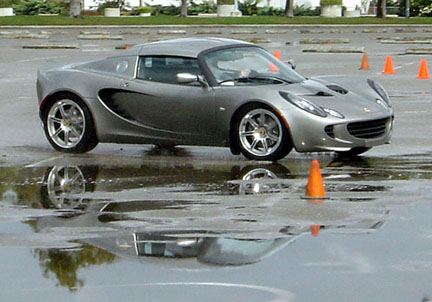
The Lotus Experience involves modifications, competition, sharing, and most of all, driving!
This chapter is Elise specific. There is also a chapter on the Exige and a great deal of common information about the 111 chassis which the Elise and the Exige share. Much of the design, staff, and press information is in the 111 chapter, shown in the navigation on the right.
Contents of My Elise Experience, Maintenance and Modifications
My Car - This is my diary of the purchase and ownership. (Formerly a rumors section...)
 Modifications - Changes people make to the Elise, modifications I have made.
Modifications - Changes people make to the Elise, modifications I have made.Comments - Miscellaneous information from owners and other sources.
Competition - Lotus in competition with the Elise and Elise-based cars.
Experience (the good):
What makes the Elise such a special car? Why do people claim it is the best handling car or the best driver's car? How is it different from other cars, even other sports or high performance cars? Here is an attempt to describe the differences. The best way to discover the reasons is to drive an Elise.
the response to steering, accelerator, and brake inputs is linear and predictable
First you have to tell the car to do something.
The steering wheel, accelerator pedal, and brake pedal are how you, the driver, tell the car to do something. The controls are all direct and your input movement has an immediate and proportional affect on the car. Move the wheel slightly to the left and the car goes slightly to the left. Push the brake hard and the car stops, hard.
the Elise will tell you exactly what it is happening
Now the car needs to tell you what it is doing.
There is a feeling you get while just driving. All your senses are alive with inputs from the car, all the time. (see below)
These sensory inputs are coming from many directions. Each message is clear, immediate, and persistent.
seating position in the car
And finally you have to listen to what the car is telling you. You will decide if it is what you wanted and if the car should continue. Or if it was not what you wanted, you can correct it.
The driver's seat is close to the center of the car. The seat is offset towards the center and the passenger seat is pushed all the way away from the center to make room for the driver. The driver's head is located close to the fore and aft center of the car, midway between the front and rear wheels.
The view forward shows the world and some reference points on the front of the car. The fenders provide a reference of where the car is pointed. You can see each corner. As the car changes direction, you are able to see where it is going easily and quickly. See also rear view comments later.
the seat
The seat is contoured to encourage support. The padding and upholstery is thin in order to make the rear of the driver make close contact to the hard part of the car. This allows the driver to feel every movement and change in direction of the car directly in the body. This is the seat-of-the-pants driving that exceptional drivers have learned and the Elise encourages.
how much fun it is to drive, the grin on the driver's face
size, shape, and feel of the steering wheel
inspires confidence, especially at the limit, wonderful balance
seating position, very close to the front and offset to the center of the car
small size, the car is tiny
great feedback from the car, what it is doing, especially at the limit
comfortable seats, thin padding, retains the driver in position
acceleration and sound of the Lotus tuned, VVTL-i engine at high revs
dramatic appearance, even appeals to people who are not car enthusiasts
single windshield wiper coverage is excellent
ease of installation of hard and soft tops
Frustrations:
- long initial brake pedal travel before braking
- poor stereo quality and sound
- uneven assembly quality such as poorly aimed headlights, water leaks
- finding 3rd gear, especially when driving aggressively
- air conditioning freezes and stops working during high ambient temperatures
- scraping the nose on ramps and driveways, especially with a passenger
- poor instrument visibility, especially the temperature gauge
- speedometer error (reads 9% fast)
- rear visibility
- quiet horn and hitting the horn going around corners
- where to put the front license plate
- quirks in the controls, horn button, light switches, alarm control, door locks
- minimal storage options
- entry and exit are fun to watch (you get used to it with time)
